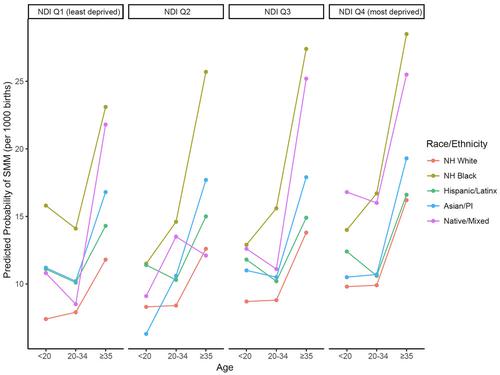当前位置:
X-MOL 学术
›
Ann. N. Y. Acad. Sci.
›
论文详情
Our official English website, www.x-mol.net, welcomes your feedback! (Note: you will need to create a separate account there.)
Racial/ethnic disparities in severe maternal morbidity: An intersectional lifecourse approach
Annals of the New York Academy of Sciences ( IF 5.2 ) Pub Date : 2022-09-27 , DOI: 10.1111/nyas.14901 Elleni M Hailu 1 , Suzan L Carmichael 2 , Rachel L Berkowitz 3 , Jonathan M Snowden 4 , Audrey Lyndon 5 , Elliott Main 6 , Mahasin S Mujahid 1
Annals of the New York Academy of Sciences ( IF 5.2 ) Pub Date : 2022-09-27 , DOI: 10.1111/nyas.14901 Elleni M Hailu 1 , Suzan L Carmichael 2 , Rachel L Berkowitz 3 , Jonathan M Snowden 4 , Audrey Lyndon 5 , Elliott Main 6 , Mahasin S Mujahid 1
Affiliation

|
Despite long-existing calls to address alarming racial/ethnic gaps in severe maternal morbidity (SMM), research that considers the impact of intersecting social inequities on SMM risk remains scarce. Invoking intersectionality theory, we sought to assess SMM risk at the nexus of racial/ethnic marginalization, weathering, and neighborhood/individual socioeconomic disadvantage. We used birth hospitalization records from California across 20 years (1997–2017, N = 9,806,406) on all live births ≥20 weeks gestation. We estimated adjusted average predicted probabilities of SMM at the combination of levels of race/ethnicity, age, and neighborhood deprivation or individual socioeconomic status (SES). The highest risk of SMM was observed among Black birthing people aged ≥35 years who either resided in the most deprived neighborhoods or had the lowest SES. Black birthing people conceptualized to be better off due to their social standing (aged 20–34 years and living in the least deprived neighborhoods or college graduates) had comparable and at times worse risk than White birthing people conceptualized to be worse off (aged ≥35 years and living in the most deprived neighborhoods or had a high-school degree or less). Our findings highlight the need to explicitly address structural racism as the driver of racial/ethnic health inequities and the imperative to incorporate intersectional approaches.
中文翻译:

严重孕产妇发病率中的种族/族裔差异:一种交叉生命过程方法
尽管长期以来一直呼吁解决严重孕产妇发病率 (SMM) 中令人担忧的种族/族裔差距,但考虑交叉社会不平等对 SMM 风险影响的研究仍然很少。援引交叉性理论,我们试图评估种族/民族边缘化、风化和邻里/个人社会经济劣势关系的 SMM 风险。我们使用了加利福尼亚州 20 年的出生住院记录(1997-2017,N= 9,806,406) 对所有妊娠 ≥ 20 周的活产。我们在种族/族裔、年龄和邻里剥夺或个人社会经济地位 (SES) 水平的组合下估计了 SMM 的调整后平均预测概率。在居住在最贫困社区或 SES 最低的年龄≥35 岁的黑人分娩人群中观察到 SMM 的风险最高。由于社会地位(20-34 岁,生活在最贫困的社区或大学毕业生)而被认为生活状况更好的黑人生育者与被认为状况更差的白人生育者(年龄≥35 岁)具有相当的风险,有时甚至更糟年并居住在最贫困的社区或拥有高中或以下学历)。
更新日期:2022-09-27
中文翻译:

严重孕产妇发病率中的种族/族裔差异:一种交叉生命过程方法
尽管长期以来一直呼吁解决严重孕产妇发病率 (SMM) 中令人担忧的种族/族裔差距,但考虑交叉社会不平等对 SMM 风险影响的研究仍然很少。援引交叉性理论,我们试图评估种族/民族边缘化、风化和邻里/个人社会经济劣势关系的 SMM 风险。我们使用了加利福尼亚州 20 年的出生住院记录(1997-2017,N= 9,806,406) 对所有妊娠 ≥ 20 周的活产。我们在种族/族裔、年龄和邻里剥夺或个人社会经济地位 (SES) 水平的组合下估计了 SMM 的调整后平均预测概率。在居住在最贫困社区或 SES 最低的年龄≥35 岁的黑人分娩人群中观察到 SMM 的风险最高。由于社会地位(20-34 岁,生活在最贫困的社区或大学毕业生)而被认为生活状况更好的黑人生育者与被认为状况更差的白人生育者(年龄≥35 岁)具有相当的风险,有时甚至更糟年并居住在最贫困的社区或拥有高中或以下学历)。


























 京公网安备 11010802027423号
京公网安备 11010802027423号